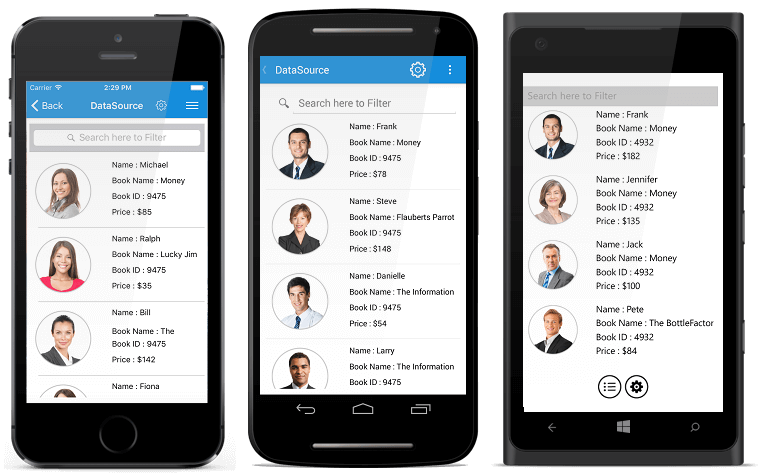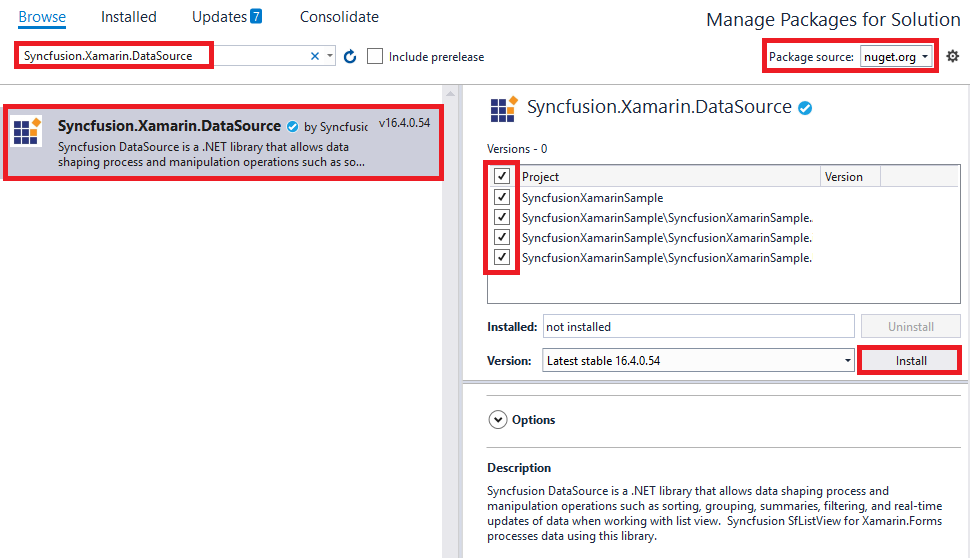Getting Started with Xamarin DataSource
21 Nov 202412 minutes to read
Overview
DataSource is a non UI component that consumes raw data and processes data operations such as sorting, filtering and grouping saving developers’ time and efforts in building the functionality themselves. We can apply DataSource to any data bound control which can be further processed using the bound DataSource.

Getting started
Assembly deployment
After installing Essential Studio® for Xamarin, you can find all the required assemblies in the installation folders, {Syncfusion Essential Studio Installed location} \Essential Studio\{Version #}\Xamarin\lib.
E.g.: C:\Program Files (x86) \Syncfusion\Essential Studio\19.1.0.54\Xamarin\lib
Refer control dependencies section to get the list of assemblies or NuGet package needs to be added as reference to use the DataSource control in any application.
NOTE
Assemblies can be found in unzipped package location(Documents/Syncfusion/{Version #}/Xamarin/lib) in Mac.
Adding DataSource reference
You can add DataSource reference using one of the following methods:
Method 1: Adding DataSource reference from nuget.org
Syncfusion Xamarin components are available in nuget.org. To add DataSource to your project, open the NuGet package manager in Visual Studio, search for Syncfusion.Xamarin.DataSource, and then install it.

NOTE
Install the same version of DataSource NuGet in all the projects.
Method 2: Adding DataSource reference from toolbox
Syncfusion also provides Xamarin Toolbox. Using this toolbox, you can drag the DataSource control to the XAML page. It will automatically install the required NuGet packages and add the namespace to the page. To install Syncfusion Xamarin Toolbox, refer to Toolbox.
Method 3: Adding DataSource assemblies manually from the installed location
If you prefer to manually reference the assemblies instead referencing from NuGet, add the following assemblies in respective projects.
Location: {Installed location}/{version}/Xamarin/lib
| PCL | Syncfusion.DataSource.Portable.dll Syncfusion.Licensing.dll |
NOTE
To know more about obtaining our components, refer to these links for Mac and Windows.
IMPORTANT
Starting with v16.2.0.x, if you reference Syncfusion assemblies from the trial setup or from the NuGet feed, you also have to include a license key in your projects. Please refer to Syncfusion license key to know about registering Syncfusion license key in your Xamarin application to use our components.
Creating your first DataSource in Xamarin.Forms
- This is how the final output will look like on iOS, Android and Windows Phone devices. You can also download the entire source code of this demo from here.

- Create a new blank (Xamarin.Forms.NET Standard) application in Xamarin Studio or Visual Studio for Xamarin.Forms.
- Now, create a simple data source as shown in the following code example. Add the following code example in a newly created class file and save it as Contacts.cs file.
public class Contacts : INotifyPropertyChanged
{
private string contactName;
public Contacts(string name)
{
contactName = name;
}
public string ContactName
{
get { return contactName; }
set
{
if (contactName != value)
{
contactName = value;
this.RaisedOnPropertyChanged("ContactName");
}
}
}
public event PropertyChangedEventHandler PropertyChanged;
public void RaisedOnPropertyChanged(string _PropertyName)
{
if (PropertyChanged != null)
{
PropertyChanged(this, new PropertyChangedEventArgs(_PropertyName));
}
}
}- Add the following code example in a newly created class file and save it as ContactList.cs file.
public class ContactsList : ObservableCollection<Contacts>, INotifyPropertyChanged
{
public ContactsList()
{
foreach (var customerName in CustomerNames)
{
var contact = new Contacts(customerName);
this.Add(contact);
}
}
string[] CustomerNames = new string[] {
"Kyle",
"Gina",
"Irene",
"Katie",
"Michael",
"Oscar",
"Ralph",
"Torrey",
"William",
"Bill",
"Daniel",
"Frank",
"Brenda",
"Danielle",
"Fiona",
"Howard",
"Jack",
"Larry",
};
}- You can set the source for the DataSource by using the DataSource.Source property. You can bind the DataSource.DisplayItems as
ItemsSourcefor any data bound control.
public App()
{
DataSource dataSource = new DataSource();
dataSource.Source = new ContactsList();
}Sorting
DataSource allows sorting the bound source by using the DataSource.SortDescriptors property. You can create a SortDescriptor for the property to be sorted and add it in the DataSource.SortDescriptors collection.
The SortDescriptor object holds following three properties:
- PropertyName: Specifies name of the sorted property.
- Direction: Specifies an object of type ListSortDirection that defines the sorting direction.
- Comparer: Specifies a comparer to be applied when sorting take place.
The following code illustrates this.
dataSource.SortDescriptors.Add(new SortDescriptor("ContactName"));Grouping
DataSource allows sorting the bound source by using the DataSource.GroupDescriptors property. You can create a GroupDescriptor for the property to be grouped and add it in the DataSource.GroupDescriptors collection.
GroupDescriptor object holds following two properties:
- PropertyName: Specifies name of the grouped property.
- KeySelector: Sets the KeySelector for grouping.
- Comparer: Comparer to be applied in when sorting take place
The following code example illustrates this without KeySelector.
dataSource.GroupDescriptors.Add(new GroupDescriptor("ContactName"));The following code example illustrates this with KeySelector.
dataSource.GroupDescriptors.Add(new GroupDescriptor()
{
PropertyName = "ContactName",
KeySelector = (object obj1) =>
{
var item = (obj1 as Contacts);
return item.ContactName[0].ToString();
}
});Binding DataSource to a ListView
Please refer the below code example that illustrates binding the created DataSource to a ListView control.
public App()
{
DataSource dataSource = new DataSource();
dataSource.Source = new ContactsList();
dataSource.SortDescriptors.Add(new SortDescriptor("ContactName"));
dataSource.GroupDescriptors.Add(new GroupDescriptor()
{
PropertyName = "ContactName",
KeySelector = (object obj1) =>
{
var item = (obj1 as Contacts);
return item.ContactName[0].ToString();
}
});
StackLayout stack = new StackLayout();
stack.Children.Add(new Label()
{
TextColor = Color.Black,
FontSize = 14,
HeightRequest = 50,
Text ="Contact List",
HorizontalTextAlignment = TextAlignment.Center,
VerticalTextAlignment = TextAlignment.Center,
BackgroundColor = Color.Gray
});
listView = new ListView();
listView.ItemTemplate = new DataTemplate(() =>
{
var label = new Label()
{
TextColor = Color.Black,
FontSize = 12,
VerticalTextAlignment = TextAlignment.Center,
BackgroundColor = Color.White,
};
label.SetBinding(Label.TextProperty, new Binding("ContactName"));
var viewCell = new ViewCell() { View = label };
viewCell.BindingContextChanged += ViewCell_BindingContextChanged;
return viewCell;
});
listView.ItemsSource = dataSource.DisplayItems;
stack.Children.Add(listView);
MainPage = new ContentPage { Content = stack };
Device.OnPlatform(iOS:() => MainPage.Padding = new Thickness(0, 20, 0, 0));
}
//Will be executed only in grouping case. Existing view in view cell will be replaced by label.
private void ViewCell_BindingContextChanged(object sender, EventArgs e)
{
var viewCell = sender as ViewCell;
if (viewCell.BindingContext is GroupResult)
{
var label = new Label()
{
TextColor = Color.Black,
FontSize = 14,
HeightRequest = 50,
HorizontalTextAlignment = TextAlignment.Center,
VerticalTextAlignment = TextAlignment.Center,
BackgroundColor = Color.Gray
};
label.SetBinding(Label.TextProperty, new Binding("Key"));
viewCell.View = label;
}
}Defining the LiveDataUpdateMode
DataSource listens manipulation operations such as add, delete, and data update (property change) at runtime and responds based on the LiveDataUpdateMode property. Default value is LiveDataUpdateMode.Default. The LiveDataUpdateMode property holds the following two enumeration values:
- Default: Refreshes an item in view when the underlying property is changed.
- AllowDataShaping: Refreshes an item in view and also updates the collection when the underlying property is changed.
private void UpdateData_Clicked(object sender, EventArgs e)
{
DataSource.LiveDataUpdateMode = LiveDataUpdateMode.AllowDataShaping;
ViewModel.Items[0].Title = "DataSourceItem_0";
}Defining the source data type
When the Source property binds with different types of underlying collection derived from the same type, set the SourceType as base type for all different types.
DataSource.SourceType = typeof(Contacts);